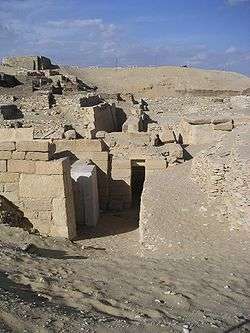Tomb of Akhethetep
The Tomb of Akhethetep (French: Mastaba d'Akhethétep), also Tomb or Mastaba of Akhethotep, is a tomb complex that was built and completed at different times in Saqqarah, Egypt. It is the tomb of Akhethotep, a royal official, located near the western part of the Step Pyramid in Saqqara. Akhethetep was an official with several, mainly religious titles. including priest of Heka, priest of Khnum and priest of Horus.[1]

The tomb was discovered in 1903 by Georges Aaron Bénédite and two female colleagues, Miss Petrie and Miss Murray. Akhethotep was a high dignitary of Ancient Egypt who lived during the Fifth Dynasty around 2400 BC and directed its construction initially.[2]Bénédite excavated the tomb and reassembled it in the Louvre in Paris. One of the depictions on the wall of the tomb was Akhethotep directing the building of the tomb.
History
In 1903, the funerary chapel of the tomb was relocated in the Louvre under the direction of Georges Benedite, the Curator of the Egyptian Department of the Museum, after it was bought from the Government of Egypt. The reassembled chapel in the Louvre is a structure of limestone blocks with bas relief that also recreates the monument as it existed originally.[3][4])
Description
Archaeologists, notably Christiane Ziegler, Jean-Pierre Adam and Guillemette Andreu-Lanoë, have identified over eight years (1991-1999) that the tomb was 32 metres (105 ft) long, 16.1 metres (53 ft) in width, respectively about 60 and 30 Egyptian cubits, 5.92 metres (19.4 ft) high present; the initial height can be estimated at approximately 6.4 metres (21 ft).[5]
The mastaba is accessed through a narrow gate topped by a scroll on which is inscribed the name of the owner. The doorway is decorated in relief with a noteworthy scene of Akhethotep transporting statues to the tomb.[2] The interior forms a small rectangular room whose left wall is pierced by a day that was formerly the tomb which contained the statues of the deceased. Akhethotep's body was buried in a subterranean vault at the end of a shaft.[2] Excavations of the limestone chapel above it have found items which were used in offerings to Akhethotep, from offering tables and statues and the remains of the sacrament funeral in the crypt among which include a canopic jar with a limestone cover plate.[2] It is highly decorated with bas reliefs, illustrating much about the life of Akhethetep on his country estate and feasts with live entertainment.[2][4] The visitors would come to offer food and drink to his spirit, and recite texts to him, which would provide him with a flourishing afterlife.[2] Among the noteworthy statues found in the vicinity of the chapel of the mastaba, is that of a man standing, probably Akhethotep, wearing a priestly garb wearing a panther skin and the insignia of the goddess Bat. It was also determined that the mastaba was plundered in antiquity and many subsequent burials took place until the Late Period.
A subterranean vault at the end of a shaft contained Akhethotep's body. However, the chapel above the tomb was accessible. The west wall with a carved false door, was considered a symbolic representation of a gateway between the land of the living and the dead.[3]
The back wall is occupied by two high false door stelae mimicking the facade of the royal palace. The set was painted in bright colors that imitate wood and fabrics adorning the double door. Other walls show classic domestic scenes of life in 2400 BC, such as farm work, hunting in the marshes (including hippopotamus and fish,[4] or the funeral of Akhethotep, meals and festivities and metaphorical images of boating down a river which allude both to his journeys in real life, and to his voyage on the waters of the dead which were to accompany him forever, on the serdab wall.[2]
During the refurbishments of the halls of the Louvre in 1985, it was analysed further and restored.[6] The analysis helped to highlight the technical characteristics that distinguish the wall of the false door from the other three walls. The wall of the false door is mainly composed of large slabs of stone, regular shape and symmetrical, surmounted by a series of smaller blocks. The other walls are conceptually different, the blocks are irregular, the most massive stones are placed on the ground, as bedrock.
References
- Ziegler, Adam, Andreu-Lanoë 2007, pp. 24-25
- "Sacrificial chamber of the tomb of Akhethotep". Heritage Key. Archived from the original on 14 March 2011. Retrieved 14 April 2011.
- "Sacrificial chamber of the tomb of Akhethotep". Heritage Unlock the Wonders Key. Archived from the original on 14 March 2011. Retrieved 9 April 2011.
- "Chapel of the tomb of Akhethotep". Louvre. Retrieved 14 April 2011.
- Ziegler, Adam, Andreu-Lanoë 2007, p. 30
- Orientalia. Pontificium institutum biblicum. 1994. p. 380. Retrieved 14 April 2011.
Bibliography
- Ziegler, Christiane; Adam, Jean-Pierre; Andreu-Lanoë, Guillemette (June 2007). Le mastaba d'Akhethetep. Peeters Publishers. ISBN 978-90-429-1922-8. Retrieved 14 April 2011.
- Bertha Poter, Rosalind L.B. Mossː Topographical Bibliography of Ancient Egyptian Hieroglyphic Texts, Reliefs and Paintings. (2nd edition) Volume III. Memphis. Part 2. Saqqara to Dahshur. (1981) page 634-637 online